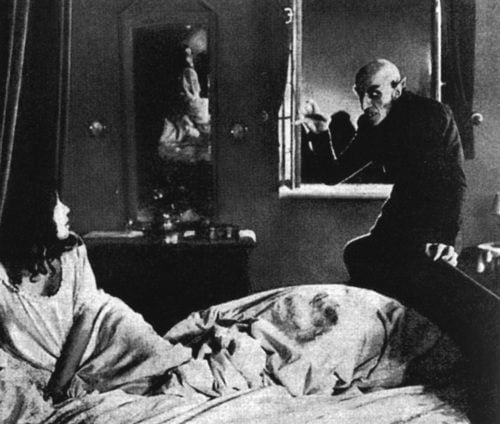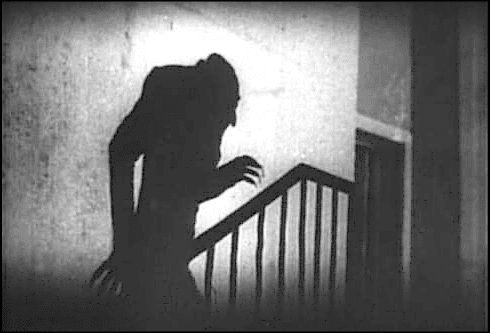
With so many horror movies available in the market, it is easy to get whatever you want. If you are a lover of slasher films, there are a plethora of movies that will meet that criteria. If a good paranormal film is more your style, take your pick. With all of these options, many seem to forget about the origins of the genre. Before you could scare yourself with a number of different styles, there was only a few movies one could watch to give you the chills, one of the most famous films on this list is Nosferatu, the black and white silent film of 1922.
The film was based on the 1897 horror novel, Dracula written by Bram Stoker. Bram Stoker in many ways spawned the vampire genre we know today. Unfortunately, he never got the praise or riches he deserved for his genius while alive. When Stoker died in 1911, he was still fighting a lifelong battle with finances. When director F.W Murnau took Henrik Galeen’s script based on Stokers novel, history was made.
Nosferatu was the first famous vampire film to ever be made, but not the first to make its way to the screen. In 1921 there was another film made simply named Dracula’s Death. Dracula’s Death was a Hungarian film directed by Karoly Latjay and it more borrows ideas and certain plot points from Bram Stokers novel more than a direct representation. It is impossible however to watch Latjay’s film as no copies survived history.
Nosferatu itself had to change many of the plot points due to copyright laws. They were not able to use Dracula’s name because they did not have the rights from Stoker’s novel. A few locations and certain plot points had to also be tweaked as well to ensure no lawsuits would come from the film. Unfortunately for Murnau and Galeen, Stokers wife received a promotional poster of the movie in the mail from an anonymous sender. She immediately took legal action against the film and company that produced it. By the time Florence Stoker was attempting to sue the company however, they had already gone bankrupt due to an expensively out of control marketing campaign. After learning that the company could pay nothing to Stoker’s family, Florence attempted to have every copy of the film destroyed, and the German court sided with her ordering every copy in the nation to be burned. Before they could all be destroyed however, some copies made their way to the U.S and UK making the film, like its star character, very difficult to kill. Florence Stoker never stopped however, and she worked to track down and burn every copy of the film until the day she died.

Some film fans may think of Bela Lugosi as the classic vampire, but Max Schreck was the one to bring Count Orlok (Nosferatu’s interpretation of Dracula) to life. However, even by today’s standards Count Orolok’s pale complexion, pointy ears, elongated fingers and animal like composer is frightening to watch. Schreck really became something other-worldly when he became the count, no matter if he was Count Dracula or Count Orlok, the man became beast. Schreck’s last name is even German for “Terror” so it seems fitting he was the one to bring life to the undead.
It is hard to watch Nosferatu in 2021 and see it as scary. Viewers sensitivity to the horror genre has changed so much since this film’s initial release, but while viewing it, one can see the fear it most likely produced in the early 20’s. For the time in film history, such camera tricks as stop-motion were not commonly used in films like this. But a few shots such as when Orlok’s coffin lid closes by itself or when the Count uses his vampire magic to open the hatch on the ship, these were done using a form of stop motion. Watching the scenes today give off an eerie feeling, leading one to believe that in the 20’s it would have been downright terrifying.
A large part of the emotions one feels from watching this film is thanks to the music proved by composer Hans Erdmann. The eerie and unforgettable organ music throughout the entire film really set the stage for what the viewer should be feeling. The original score was played with an orchestra at the time of the films screening. However, over time the original has been lost so what the films have today is a reconstruction of Erdmann’s music.
It has been said that this film, given its location in Germany and the appearance of Count Orlok as well as his relationship with rodents was a direct representation of the anti-Semitic ideologies a lot of people had in the 1920’s. However, there has been proof that director Murnau was close with many Jewish men and women and was in fact himself, a homosexual. Because of these facts, it is hard to believe that Murnau would have any ties to Nazi propaganda at all.
Watching the film in 2021 gives one a sense of history and respect for the arts. All though the film blatantly stole the idea from Bram Stoker, it is considered to be one of the greatest horror films of all time, and I can see why. It transports you back to a time when film was in its infancy, a new creature unsure of itself. With little tools to help it along and only vision and grit to push it into the future. Thanks to Nosferatu, the vampire genre is full of thousands of different stories and characters that can all be traced back to this one film.
Watch “Nosferatu: A Symphony of Horror” on TheLastPicture.Show
Written exclusively for TheLastPicture.Show by Jacob Ruble
Disclosure: The links on this page are “Affiliate Links” and while these are shown at no costs to our viewers, they generate commissions for our website(s)

